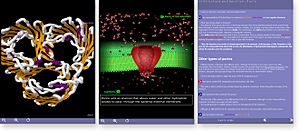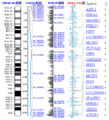Computational biology facts for kids
Computational biology is an exciting field that mixes computer science, mathematics, and statistics with biology. It uses powerful computers and smart programs to solve big puzzles in biology. Think of it as using computers to understand how living things work, from tiny cells to whole animals!
Many people who work in computational biology have studied biology, engineering, physics, statistics, or chemistry. They bring different skills to help understand life's secrets.
Contents
- What Does Computational Biology Do?
- Bioinformatics: Understanding Life's Code
- Computational Biomodeling: Building Digital Life
- Computational Genomics: Exploring Our Genes
- Molecular Modeling: Seeing Tiny Molecules
- Systems Biology: The Big Picture of Life
- Protein Structure Prediction: Unlocking Protein Shapes
- Computational Biochemistry and Biophysics: How Molecules Move
- Images for kids
- See also
What Does Computational Biology Do?
Computational biology helps us understand life in many ways. It uses computers to look at huge amounts of biological information. Here are some of the main areas:
Bioinformatics: Understanding Life's Code
Bioinformatics is a big part of computational biology. It uses algorithms (step-by-step computer instructions) and math tools to study biological data. This data often includes long sequences of DNA, RNA, or proteins.
For example, bioinformatics can:
- Compare sequences: It can line up and compare different DNA or protein sequences. This helps scientists find similarities between them. It can also help find genes.
- Predict gene activity: It can guess which genes are active in different parts of the body or at different times.
Sometimes, people use "computational biology" and "bioinformatics" to mean the same thing.
Computational Biomodeling: Building Digital Life
This area focuses on creating computer models of biological systems. Imagine building a digital heart or a virtual plant to see how it works. These models help scientists test ideas without needing to do experiments in a lab.
Computational Genomics: Exploring Our Genes
Computational genomics looks at the entire set of genes (the genome) in cells and organisms. Scientists use special machines to read these genes very quickly. This process is called genome sequencing.
After reading the genes, computers help put them all in the right order. This is like putting together a giant puzzle! This field also uses tools like DNA microarrays to study which genes are active in different types of cells.
Molecular Modeling: Seeing Tiny Molecules
Molecular modeling uses computers to create pictures and models of molecules. These can be tiny molecules with just a few atoms or very large ones like proteins. It helps scientists understand how molecules behave and interact with each other. This is useful for designing new medicines or understanding diseases.
Systems Biology: The Big Picture of Life
Systems biology tries to understand how all the different parts of a biological system work together. It's like looking at a whole city instead of just one house. Scientists often use differential equations (a type of math) to model these complex networks. They want to see how different parts of a cell or body interact.
Protein Structure Prediction: Unlocking Protein Shapes
Protein structure prediction tries to figure out the 3D shape of proteins. Proteins are like tiny machines in our bodies, and their shape is very important for how they work. Sometimes, it's hard to find a protein's shape in a lab. Computational biology uses computers to predict these shapes, which helps us understand diseases and develop new treatments.
Computational Biochemistry and Biophysics: How Molecules Move
These fields use computer models and simulations to study how molecules like proteins move and change. They use methods like molecular dynamics to watch molecules in action. This helps scientists understand how proteins do their jobs and how energy is used in biological processes.
Images for kids
-
This timeline shows the progress of the Human Genome Project. This project aimed to map all the genes in humans.
See also
 In Spanish: Biología computacional para niños
In Spanish: Biología computacional para niños






